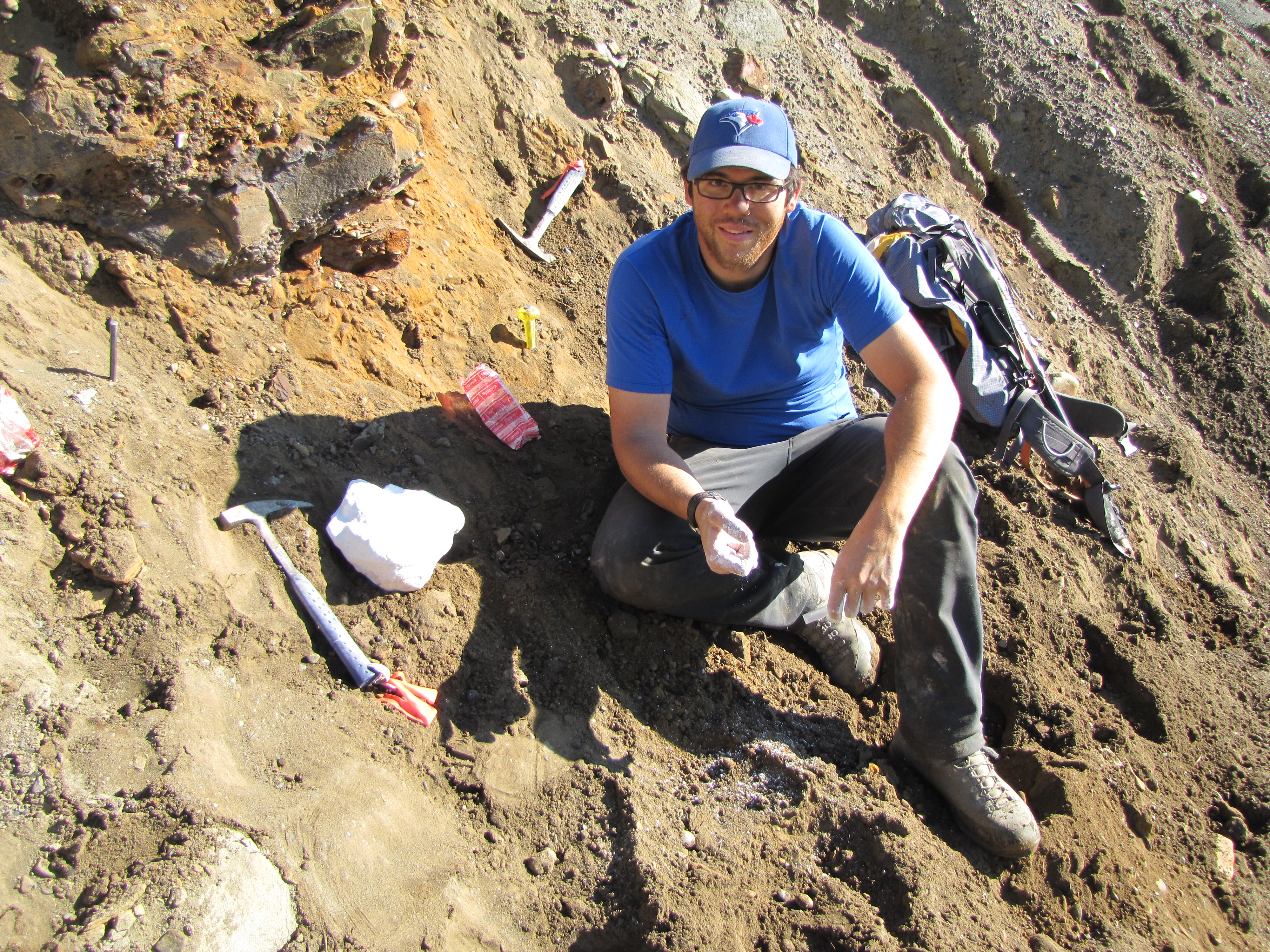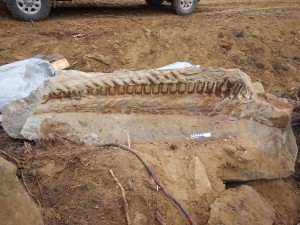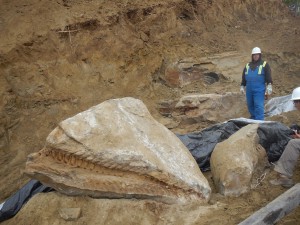February 2014, Vol. 241 No. 2
Features
Tourmaline Pipeline Team Uncovers Gigantic Dinosaur Fossil In Alberta

On Oct. 1, a crew working for Tourmaline Oil Corp. was clearing the right-of-way for a new pipeline near Spirit River, Alberta, Canada when they cracked open a rock that revealed the massive fossil of a dinosaur tailbone.
Shocked, the crew immediately stopped operations and contacted the necessary officials. The team was only required to report the find, but instead these pipeliners went above and beyond, providing heavy equipment, supplies and manpower to the paleontologists assigned to recover the fossil. Ultimately, it became a classic example of how industry and science can work together where everyone comes out a winner.
Dr. Matthew Vavrek, Pipestone Creek Dinosaur Initiative head paleontologist, was on the scene the following day and shared with Pipeline & Gas Journal the tenacious partnership developed between the pipeliners and paleontologists, the proper protocol construction companies should follow in dealing with fossil finds, and a new dinosaur museum being built in Grand Prairie, Alberta that will dedicate an entire wing to the oil and gas sector.
P&GJ: At what point did the construction crew stop the pipeline right-of-way and realize that they had encountered a fossil?
Vavrek: They were clearing the right-of-way to put in the pipeline and leveling off the ground. As they were doing this, near the top of this small hill, they went down a little lower and came across this large rock. The rock wasn’t in their way but was close to where they might be trenching, so they decided to move it. One of the track hoe guys busted the first chunk off and the rock split in two. He moved half of the big piece off to the side, came back for the other one and saw this complete tail of a dinosaur.

Even though they weren’t entirely sure what it was, the crew knew they needed to stop work and call someone because whatever it was, it was going to be important.
The next day I was onsite trying to figure out how to get the fossil out of the ground. Someone arrived from the Royal Tyrrell Museum and we talked further. It was on Monday that they found the fossil and by Thursday there was a track hoe onsite trenching around the rest of the rock. The chunks of the tailpiece were between 6,000-7,000 pounds. The tail section shown in all of the pictures was about seven feet long.
P&GJ: What kind of a dinosaur did the crew find?
Vavrek: It’s a duck-billed hadrosaur. We know the general group it’s in, but because most of it was still inside of the rock we can’t really tell. Hadrosaurs are very similar from the neck down. Usually when you find a skeleton you can’t identify them very well without having the skull. Until the whole thing is extracted from the rock, probably a couple of years from now, we won’t be able to fully tell.

P&GJ: What goes into the process of recovering a fossil? What is the update on the project?
Vavrek: We used the track hoe to trench around the rock. It was nice because the fossil itself was in a fairly hard rock, but around that were softer sands so it was easy to trench around it. Sometimes with fossils you have to put plaster around the entire piece to keep it stable – like an arm cast after you break it. Essentially, you’re making a support cast around the fossil. Because it was so big, most of what was being exposed was rock, not fossil. We only had to use a little plaster which saved us a lot of time.

After we trenched it, we put plaster around the fossils that were sticking out of the rock and used the track hoe to take it out piece by piece. It had already broken off into a few smaller-sized pieces from natural erosion. We spent a day on the last block trimming it down with rock saws and jackhammers and it still weighed around 17,000 pounds. In total, there was about 54,000 pounds of rock that we took out of that hole. It took two flatbed trailers to get it all down from Spirit River, which is north of Grand Prairie, to the Tyrrell Museum’s storage site.
It is just sitting there at the storage site because the blocks are so big we can’t take them inside the paleontology lab. There is a crane they use to move fossils around inside the lab but the crane is only rated at three tons and our biggest block is eight tons. There are definite logistical problems trying to deal with this. One technician from the Tyrell who has been digging up dinosaurs for over 30 years said this was the biggest he’d ever collected.
However, the overwhelming majority of that is actually rock, not fossil. Because of where it was, we needed to collect a lot more of the rock than we normally would. If we were trying to do this by hand, there is no way we could have moved those blocks ourselves. Because we had that track hoe, we knew it would be a lot faster for us and better for Tourmaline as well to remove it quickly so that we could deal with the task of trimming it in a more contained environment.

P&GJ: Is there a long history of contractors reporting these finds?
Vavrek: There is a long history of companies reporting these sorts of things to institutions. In northeast Alberta the oil sands have produced several marine reptiles and dinosaurs. They are extremely well-preserved and in some cases you can get complete animals literally from head to tail. They’ve been doing that for 20 years since mining began.
Sometimes there is hesitancy because companies want to keep the job moving forward. Time is money. A lot of companies realize that money isn’t everything. At Spirit River, they never stopped working on the pipeline; they just stopped working on that section. They moved down the line to do other work and rearranged their schedules so that they didn’t have down time, but still gave us the space we needed.
P&GJ: What are the laws for contractors when they come across a find like this?
Vavrek: In Alberta there are fairly strong laws regarding fossil protection. If a company finds a fossil, they must report that to Alberta Culture. There is a big difference between a lot of places in Canada and the U.S. For example, in the U.S. you can privately collect and own fossils whereas in Alberta or Saskatchewan fossils are public property and part of the public common.
P&GJ: How was Tourmaline to work with during this process?
Vavrek: We couldn’t have done it without their help. Legally, they didn’t need to do anything other than tell us the fossil was there. They constantly checked in on us to make sure we had everything we needed. They had a track hoe parked beside the hole ready to go whenever we needed it. They didn’t have to supply us with those resources. Trying to get heavy equipment in on paleontology projects is a significant expense.

They wanted to help us get it out as quickly as possible and saw that it was a good way to spend their money because then we could do our job a lot faster. We needed a generator and they got us one in less than a half hour. We needed tarps which they had for us. We were far from any real town so when we needed supplies they usually had it.
P&GJ: Should there be a training program set in place for construction crews on the proper procedures when finding a fossil?
Vavrek: It wouldn’t be a bad idea to do some outreach. Making it mandatory for everybody doesn’t make any sense because there’s a lot of construction work that goes on in different places where you’re never going to find fossils. The kinds of rocks that are there just never produce them, but at the same time there is work that goes on in areas that are known to have a good number of fossils.
The biggest thing that I could do as a paleontologist is to say “You’re going into an area with high potential for fossils. These are sometimes what the fossils look like. If you see them, let us know.” I don’t think it needs to be a mandatory thing because we have been seeing good results without having any training in place.
P&GJ: What is the new Philip J. Currie Dinosaur Museum now being built and how it is related to oil and gas?
Vavrek: Alberta is big into oil and gas. Grand Prairie, in particular, has a big and booming oil and gas production industry. We want to feature the oil and gas work going on here because there is a long history of geology, paleontology and oil and gas resource development working together. In Alberta, it’s amazing how well worked-out the geology is, which is a great benefit to me as a paleontologist.
If I go to an area, I know what the rocks are, what age they are and what kind of an environment that dinosaur would have been living in. This is largely because there has been extensive geological survey work supported by the oil industry or the Alberta government trying to encourage oil and gas development.
There is a lot we can teach people about oil and gas, especially from the perspective of geology and paleontology. Most people will say “I’m going to go and fill up the car with dinosaur juice,” but no, the gas and oil you get out of the ground has nothing to do with dinosaurs.
There is this idea that the oil and gas we are getting out of there is coming from dinosaurs and in some cases plants. In reality, a lot of the oil and gas that we have in Alberta comes from algae and other unicellular organisms that were living in oceans. There is a long process that everything goes through that determines how an oil or gas basin develops.
P&GJ: When is this new museum supposed to be completed?
Vavrek: The building is scheduled to be done in the fall with the opening Dec. 20-14. The grand opening is in August with the Amber Ball that will include several celebrities, the premier of Alberta, lieutenant governor and prime minister may be coming. Things are well underway and are moving at full steam ahead.
By Kate Permenter, Pipeline News Editor





Comments